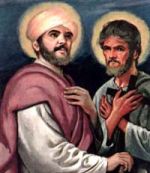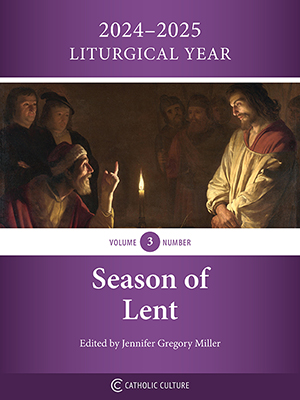The Celtic Spirits
Patrick would roll in his grave if he could see the current craze over Celtic spirituality. After all, he's the man who Christianized the Celts.
He might enjoy the revival of music and dance. But Patrick would know something that the public does not: namely, that some music and dance are more authentic and some less. The same caveat must be writ large with respect to "Celtic spirituality." Some of the stuff is about as Celtic as a border collie.
Something for Everyone?
One book publicist put it with amazing frankness: "At a time when many people are seeking out the comforts of traditional beliefs, but remain wary of overly confining disciplines, Celtic spirituality offers something for almost everyone." That's certainly true in the case of one exponent of things Celtic, the pantheistic nature-mystic Matthew Fox.
It's true the ancient Celtic prayers show an appreciative sense of the divine penetration of nature. But so does Catholicism anywhere. It's true that ancient Irish society had a greater respect for women than the Protestant tradition dominant since the 16th century—but so did every Catholic culture. It's true the concept of spiritual friendships, evidently brought to ancient Ireland by the Desert Fathers of Egypt, reached new heights with the Irish monks. But the concept has not been forgotten since the Norman invasion. So the idea of "something for everyone" translates to "something for everyone who doesn't want a connection with Catholicism."
Case in point: "The Road Wet, The Wind Close," by James Charles Roy (Dufour Editions), is a journey through ancient locations of pre-Christian and Christian significance, with comment that links archeology, architecture, travel and history with fine black-and-white photographs to substantiate the points. It's a pleasant read. But when a discussion of the perpetual virginity of Mary takes a snide tone, one begins to wonder. "The growth of Mary into a perpetual rather than temporary virgin came later during the second, third and fourth centuries," he says. And then: "The logical culmination to this entire sequence was the doctrine of Immaculate Conception."
First of all, there was no recorded challenge to Mary's perpetual virginity until the 5th century. And any Catholic knows that the Immaculate Conception has nothing to do with the perpetual virginity. One can only hope the author knows more about archeology than he does about the history of dogma.
Other authors, who are outright pagans, make no pretense of scholarship, I chose two books at random from the "New Age and Occult" section of a chain bookstore: "Witta: An Irish Pagan Tradition and Celtic Myth" and "Magick: Harnessing the Power of the Gods and Goddesses," both published by Llewellyn Publications. In the latter book, the author opines: "One of the most attractive things about paganism is that it does not require enslavement to a dogma."
That's what she thinks. We may hope St. Patrick is praying that she and her followers will be delivered from their delusion before they become enslaved to the very real person who rules the smoking section.
The Primary Sources
Indisputably good are the primary sources. The most primary has been recently republished. "The Confession of Saint Patrick," translated by John Skinner (Doubleday Image), includes the breathtaking "Letter to the Soldiers of Coroticus." Both are in a free-verse format, which has the advantage of making the reader slow down. No doubt the good saint — who was always embarrassed because his Latin wasn't as good as he felt it should have been — would approve of anything that renders his own words better appreciated.
Doubleday Image has also issued some excerpts from the four volumes of the Carmina Gadelica, a century-old collection of the prayers, songs and poetry of native Gaelic speakers. The new mini-version is called "Celtic Prayers."
The Carmina, both in Gaelic and in English, is also now a website (www.smo.uhi.ac.uk/gaidhiig/cor-pus/Carmina), as are the Book of Kells (www.tcd.ie/kellsl.git) and the Lindisfarne Gospels (www.bl.uk), all worth visiting.
Almost as good, for young readers, are a few by George Otto Simms, former Church of Ireland Archbishop of Armagh. "The Real Story of Patrick" is a narrative based on the "Confessions." In the same series is one on St. Brendan and an appreciation of the Book of Kells.
Next come some serious appreciations. "The World of Columcille, also known as Columba," by Mairead Ashe Fitzgerald, not only does justice to a personality who has been legendary for 14 centuries, but also gives background on Irish monasticism and the pilgrims sent from Ireland to preserve faith and learning throughout Europe. Simms and Fitzgerald are published in Ireland, but are readily available in the United States through the recently organized Irish American Book Company (phone: 800-452-7115). The IABC is refreshingly lacking in pop titles.
Two Good Ones
After the original sources come two not to be missed by anyone who really wants to learn more about authentic Celtic spirituality.
"The Music of What Happens," by John J. O. Riordain, C.Ss.R. (St. Mary's Press), is a sensible exploration of what is unique in the Irish approach to God. O. Riordain, a priest in Ireland, grew up living the Irish way — before the fad existed. He knows the old ladies who have daily conversations with the saints, and who have their occasional tiffs with "Himself above.
This familiarity goes back to the way the ancient Celts lived. They didn't live in town; they lived in tuaths, rural communities organized around kinship ties. The ard-ri (translated as high king) ruled over a clan; he was everyone's cousin, and blood was what mattered. The lowliest child could speak to the king as freely as the fiercest warrior could. In Europe, however, kings were something different: mighty, powerful, distant, frightening. Prayers addressed to God as King meant one thing to an Irishman who grew up sitting on his own king's lap, and quite another to a Frenchman who grew up in terror of his king. Hence the familiarity of Irish Christianity with God and His saints.
Hence, also, some of the historical tragedies. Because Ireland didn't have a city worth the name, the Roman system of bishops (who had to have cities as their sees) was a long time settling in. Every tuath had its own monastery, and the abbot was the powerful cleric around, not the bishop. And because there was no communication with Europe after the fall of Rome, Ireland heard only rumors when the date of Easter was changed, and so kept to the way they'd always done it, and kept on tonsuring monks the way they always had. Both of which became the pretext, then, for Pope Adrian IV to give newly installed King Henry II of England permission to conquer Ireland in 1154: to bring it into conformity with the practice of the Church of Rome. How bitter an irony, considering that England would not have been Christian if it hadn't been for the efforts of St. Columcille a few centuries earlier.
An interesting side-effect of this history is that, today, people with grievances against Rome are looking to pre-12th-century Irish Christianity to show them how to be Catholic without the pope. This is evident among some of the more, um, "progressive" so-called Catholics as well as among other Christians.
The Celtic Way of Prayer
I have saved the best for last. Esther de Waal was a history professor who retired to raise her children. She moved into an old house that had been part of a medieval monastery. That coincidence was the beginning of her interest in Benedictine and Celtic spiritual traditions. "The Celtic Way of Prayer: The Recovery of the Religious Imagination" (Doubleday) is a serious masterpiece. Here are no fairies or sentimental whimsies: "The Celtic way of prayer was learned from monasteries; it was from its religious communities that people learned to pray. As a result, they learned that there was no separation of praying and living; praying and working flow into each other, so that life is to be punctuated by prayer, become prayer." Since the people lived among stone and tree, dependent upon sun and rain, stone and tree and sun and rain entered into the prayer. Daily life depended very much on God, and nobody was sophisticated enough (or silly enough) to pretend otherwise. Gratitude was abundant. Prayer was the undercurrent of everything they did — and is that not the essence of mental prayer?
De Waal does a thorough analysis of the style of ancient Celtic prayers. Her analysis shows how they work, wherein lies their charm and their uniqueness.
But knowing about Celtic prayers is only the first step. Knowing them must come from praying them.
Pray I this day my prayer to Thee, O God,
Voice I this day as voices the voice of Thy mouth,
Keep I this day as keep the people of heaven,
Spend I this day as spend Thine own household.Each thing I have received from Thee it came,
Each thing for which I hope, from Thy love it will come,
Each thing I enjoy, it is of Thy bounty,
Each thing I ask, comes of Thy disposing,And grant Thou to me. Father beloved,
•
From Whom each thing that is freely flows,
That no tie over-strict, no tie over-dear
May be between myself and this world below.
Marshner writes from Front Royal, Va. © New Covenant, Our Sunday Visitor, Inc., 200 Noll Plaza, Huntington, IN 46750-9957 or call 1-800-348-2440.
This item 1025 digitally provided courtesy of CatholicCulture.org






